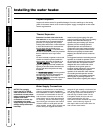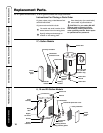
Routine Preventative Maintenance
Properly maintained, your water heater
will provide years of dependable trouble-
free service.
It is suggested that a routine preventive
maintenance program be established
and followed by the user.
It is further recommended that a
periodic inspection of the operating
controls, heating element and wiring
should be made by service personnel
qualified in electric appliance repair.
Most electrical appliances, even when
new, make some sound when in
operation. If the hissing or singing
sound level increases excessively, the
electric heating element may require
cleaning. Contact a qualified installer or
plumbing contract to inspect.
At least once a year, lift and release the
lever handle on the temperature pressure
relief valve, located near the top of the
water heater, to make certain the valve
operates freely. Allow several gallons to
flush through the discharge line to an
open drain.
A water heater’s tank can act as a
settling basin for solids suspended in
the water. It is therefore not uncommon
for hard water deposits to accumulate in
the bottom of the tank. It is suggested
that a few quarts of water be drained
from the water heater’s tank every month
to clean the tank of these deposits.
Rapid closing of faucets or solenoid
valves in automatic water using
appliances can cause a banging noise
heard in a water pipe. Strategically
located risers in the water pipe system
or water hammer arresting devices can
be used to minimize the problem.
The anode rod should be removed from the
water heater’s tank annually for inspection
and replaced when more than 6″ of core
wire is exposed at either end of the rod.
Make sure the cold water supply is
turned off before removing anode rod.
NOTICE: Do not remove the anode rod
from the water heater’s tank, except
for inspection and/or replacement,
as operation with the anode rod
removed will shorten the life of the
glass lined tank and will exclude
warranty coverage.
Care and cleaning of the water heater.
Draining the Water Heater
CAUTION: Shut off power to the
water heater before draining water.
DANGER: Before manually operating
the relief valve, make certain no one will
be exposed to the hot water released
by the valve. The water drained from
the tank may be hot enough to present
a scald hazard and should be directed
to a suitable drain to prevent injury or
damage.
In order to drain the water heater, turn
off the cold water supply. Open a hot
water faucet or lift the handle on the
relief valve to admit air to the tank.
Attach a garden hose to the drain valve
on the water heater and direct the
stream of water to a drain. Open the
valve.
Vacation and Extended Shut-Down
If the water heater is to remain idle for an
extended period of time, the power and
water to the appliance should be turned
off to conserve energy and prevent a
build-up of dangerous hydrogen gas.
The water heater and piping should be
drained if they might be subjected to
freezing temperatures.
After a long shut-down period, the water
heater’s operation and controls should
be checked by qualified service personnel.
Make certain the water heater is
completely filled again before placing it
in operation.
NOTICE: Refer to the
Hydrogen Gas Caution in
the Operating Instructions.
DANGER: Before
manually operating the
relief valve, make certain
no one will be exposed to
the danger of coming in
contact with the hot water
released by the valve. The
water may be hot enough
to create a scald hazard.
The water should be
released into a suitable
drain to prevent injury or
property damage.
NOTICE: If the temperature
and pressure relief valve
on the hot water heater
discharges periodically,
this may be due to thermal
expansion in a closed
water system. Contact
the water supplier or
your plumbing contractor
on how to correct this.
Do not plug the relief
valve outlet.
14
Customer Service Troubleshooting Tips Care and Cleaning Operating Instructions Installation Instructions Safety Instructions
DANGER: Hotter water
increases the potential for
Hot Water Scalds.
!


















